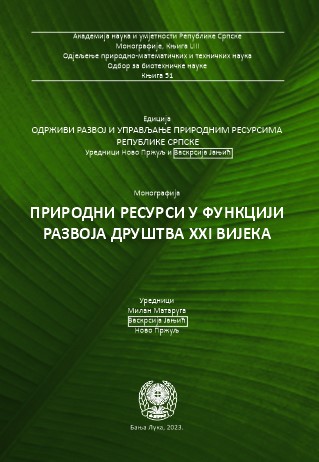Renewable energy sources and their role in the future of energy system of Republic of Srpska
DOI:
https://doi.org/10.7251/EORU2307139GKeywords:
Renewable energy sources, hydro energy, wind energy, geothermal energy, solar energy, biomass, climate changes, energy transitionAbstract
In the last decades use of energy on the global level has been increased exponentially. In the global ranges participation of fossil fuels in primary energy consumption in 2019 was 84,32%., which was one of the reasons for the ncreased interest for renewable energy sources, and secone one is gobal combating climate changes. Paris agreement (bellow the level of 2,0оC). It is especially important to emphasize that the European Union in its strategic plans is going in the direction of decarbonization of society by 2050 and is trying to impose itself as a world leader in new technologies, energy efficiency and the use of renewable energy sources. The holder of the electric power sector of the Republic of Srpska is „Elektroprivreda Republike Srpske", which is organized as a mixed holding. It includes the thermal power plants Gacko (300 MW, lignite) and Ugljevik (300 MW, brown coal), along with their associated coal mines, and three hydropower plants on Trebišnjica (314 MW), Drina (315 MW) and Vrbas (110 MW), and four small hydropower plants. Beside of the state company in Republic of Srpska, thermal power plant Stanari (300 MW), which is private ownership, also producing electric energy. The same company is the owner of the concesion on Stanari coal mine. Beside of that, some private owned renewable energy plants also producing electric energy, and which excercize incentives for that, 16 small hydro power plants (40,82 MW), and according to data from 2018 there were 48 small and big solar electric plants. Production of coal thermal power plants in 2016 in Republic of Srpska was 4,8 TWh, while electricity production from hydro power plants was 2,5 TWh. One of general characteristics of electric power sector is non-adequate strategic planning, slow pace of reforms, and thanking to electric power sector, economy of Bosnia and Herzegovina is one of the energy most inefficient and carbon most intensive in Europe. Heat energy in Republic of Srpska is mostly used in the households, which makes around 76% of the final consumprion of heat. District heating systems in Republic of Srpska exists strictly in the urban areas or some parts of the urban areas. According to available data around 40.000 of the appartments are connected to district heating systems, which is around 2,3 million of m2 and 460.000 m2 of thebussines users. They are supplied by 12 district heating systems organized as public enterprises. Taking in to consideration long-term goal of Bosnia and Herzegovina, and therefore Republic of Srpska is a full membership in European Union, it should be emphasized that renewable energy sources are very high on its priorities lists. Hydro energy potential of Republic of Srpska is currently used around 32%. By making insught in sector status, general impression is that hydro potential is not continuously realized, brcasue large projects are postponed or canceled, and development of smal hydropower projects is slow. When it comes to solar potential, Bosnia and Herzegovina belongs to the countries that are considered locationally desirable for the use of solar energy, because it has an average of 1840.9 hours of sunshine per year, while in the south the number reaches 2352.5 hours. It is considered economically feasible to install 1000-1200 MW of wind farms in Bosnia and Herzegovina. According to available data geothermal energy in Republic of Srpska is relared to the artesian wells of its north part from Una to Drina River with the temperatures from 37 – 75 oC. Technical potential of wooden biomass in Republic of Srpska, according to Biomass Atlas is estimated to 939.911 tons of dry matter annualy, while potential of biomass from secondary processes of treatmet is 449.273 tons of dry matter annualy. According to the calculations of the Energy Community of Southeast Europe, BiH had a real opportunity to increase the share of renewable sources in the total energy potential from 26.5% in 2005 to 33% by 2020, a similar relationship in Republika Srpska. Looking back two decades and the development of processes related to the use of renewable energy sources in Republika Srpska, the conclusion is that this development is slow and does not follow the trends of the European Union, but also the obligations that Bosnia and Herzegovina undertook in the Energy Community Treaty. There are many reasons for that, and some of the key barriers are corruption at all levels of government, but also insufficient development of transmission systems to be able to receive significant capacities of intermittent RES. Renewable energy sources can play a significant role in the economy of Republika Srpska, but how much that role will really be, primarily depends on the decision makers in Republika Srpska according to this resource.
